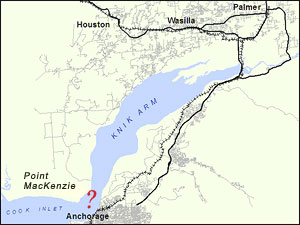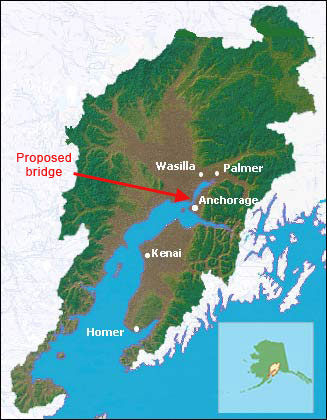Click here to return to the news items list on the main page.

Is the proposed Knik Arm Bridge a good idea or a "Bridge to Nowhere"?
Who will benefit and who will be harmed if the bridge is built?
Are there other alternatives that should be considered?
What will the bridge cost and who will pay for it?
This website provides factual information and documentation to answer these questions.

Website administrator: Lois Epstein lois@aktransportation.org
News and Events
Thursday, May 28, 2009
"The results of the review indicate that there is a 90% likelihood that the range of all costs (e.g. construction, contingencies, support, environmental mitigations, engineering, utilities, right-of-way, tolling, etc.) for the entire Project will be between approximately $1.5 billion and $1.6 billion. For Phase 1 [i.e., connecting to A/C Streets and a 2 lane bridge], the 90% likelihood is between approximately $670 million and $740 million. For Phase 2 [i.e., connecting to Ingra-Gambell and a 4 lane bridge], the 90% likelihood is between approximately $750 million and $920 million. For Phase 2, the review team had to develop assumptions for construction work that could be scheduled between 10 and 20 years out. For Phase 2, especially, the impact of cost escalation is the largest factor in the variability of costs." (p. 3).
Please click here for the full report. (PDF format, 1.8M)
Thursday, May 28, 2009
New Report: Knik Arm Crossing Cost Estimate Review (Final), Federal Highway Administration, May 2009
From the Executive Summary:"The results of the review indicate that there is a 90% likelihood that the range of all costs (e.g. construction, contingencies, support, environmental mitigations, engineering, utilities, right-of-way, tolling, etc.) for the entire Project will be between approximately $1.5 billion and $1.6 billion. For Phase 1 [i.e., connecting to A/C Streets and a 2 lane bridge], the 90% likelihood is between approximately $670 million and $740 million. For Phase 2 [i.e., connecting to Ingra-Gambell and a 4 lane bridge], the 90% likelihood is between approximately $750 million and $920 million. For Phase 2, the review team had to develop assumptions for construction work that could be scheduled between 10 and 20 years out. For Phase 2, especially, the impact of cost escalation is the largest factor in the variability of costs." (p. 3).
Please click here for the full report. (PDF format, 1.8M)